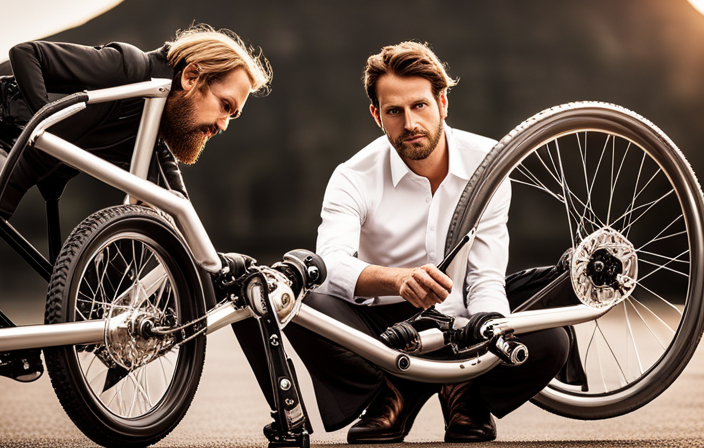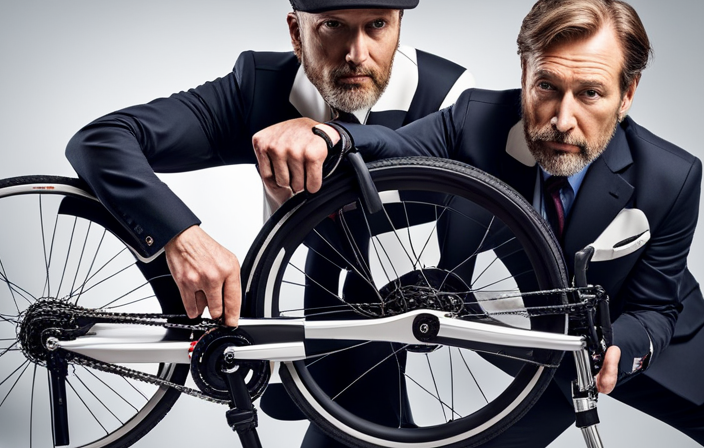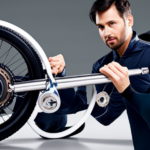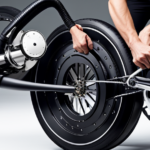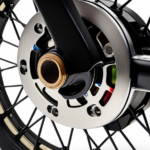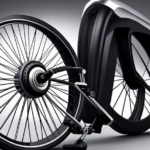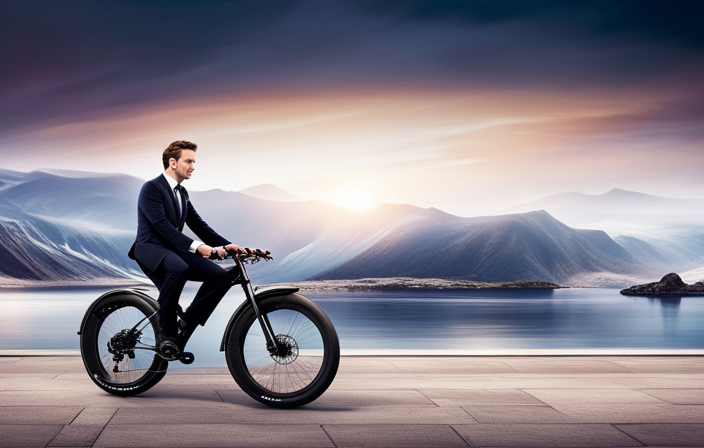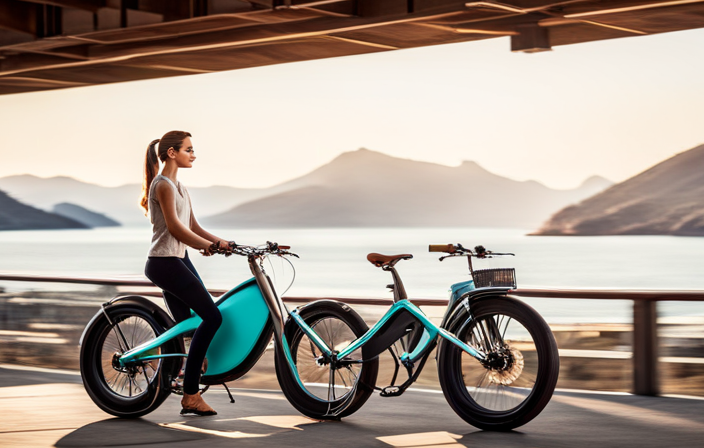As I grip the handlebars and feel the hum of electricity beneath me, I know it’s time to delve into the inner workings of my electric bike. Opening the front wheel hub motor is like peering into the heart of this two-wheeled beast.
With the right tools and precautions, I’ll guide you through the intricate process of accessing the motor. From disconnecting the power to reassembling the wires, we’ll ensure a smooth ride as we unlock the mysteries of the front wheel hub motor.
Key Takeaways
- Disconnect the motor wires and ensure the battery is disconnected and the bike is secured.
- Carefully inspect the motor for visible signs of damage or issues, such as cracks, dents, frayed wiring connections, or wear on the bearings and shaft.
- Thoroughly clean the motor components using a soft brush or compressed air, and wipe them down with mild soap and water. Use a lubricant designed for electric motors to lubricate the bearings and gears.
- When reassembling the motor, refer to the wiring diagram for correct wire connections and securely connect the wires using connectors or soldering. Reattach the motor cover and install the front wheel, making sure to align the axle, brake rotor, and caliper properly. Test the wheel rotation for smoothness.
Tools Needed for Opening a Front Wheel Hub Motor
To open a front wheel hub motor on an electric bike, you’ll need a few tools. Here is a step-by-step guide on the tools required for this process.
Firstly, you will need a set of Allen wrenches in various sizes. These will be used to remove the bolts securing the motor to the fork.
Additionally, a pair of pliers will come in handy for holding onto small parts or fasteners.
A screwdriver with interchangeable bits is also necessary for removing any screws or bolts that may be holding the motor cover in place.
Finally, a torque wrench is essential for ensuring that the bolts are tightened to the correct specifications when reassembling the motor.
With these tools at hand, you can proceed to the next section where we will discuss the safety precautions before opening the motor.
Safety Precautions Before Opening the Motor
Before you start, make sure you’ve taken the necessary safety precautions to prevent accidents and ensure a safe working environment. Here are the essential safety measures to consider:
- Wear protective gear such as gloves, safety glasses, and closed-toe shoes.
- Disconnect the electric power supply to avoid any electrical shocks.
- Clear the work area of any potential hazards or obstacles.
- Keep a fire extinguisher nearby in case of emergencies.
- Work in a well-ventilated area to avoid inhaling any harmful fumes.
By following these safety measures, you can significantly reduce the risk of accidents and injuries while opening the front wheel hub motor.
Now, let’s move on to the next section where we will discuss the process of disconnecting the electric power.
Disconnecting the Electric Power
Make sure you’ve disconnected the power supply to prevent any electrical hazards.
The first step in disconnecting the electric power is to remove the battery from the electric bike. This is crucial to ensure that there is no power flowing through the system. Locate the battery pack, typically located on the frame of the bike, and carefully detach it from its mount.
Next, you’ll need to remove the motor controller, which is responsible for controlling the power delivery to the motor. This is usually located near the motor itself and is connected to the battery via a wiring harness. Disconnect the wiring harness by carefully unplugging the connectors.
Once the battery and motor controller are disconnected, you can proceed to removing the front wheel from the bike.
Removing the Front Wheel from the Bike
Once you’ve disconnected the battery and motor controller, you can proceed to detach the front wheel from the frame. To remove the front wheel, follow these steps:
-
Loosen the axle nuts on both sides of the wheel using a wrench. Make sure to remove any safety clips or washers that may be present.
-
Place a block or stand under the frame to support the bike and prevent it from falling over.
-
Lift the bike slightly off the ground to relieve pressure on the front wheel. This will make it easier to slide the wheel out of the fork dropouts.
Now, with the front wheel removed, we can move on to the next step of removing the axle nut and washers.
Removing the Axle Nut and Washers
Now that the front wheel is removed, it’s time to take off the axle nut and washers. To do this, you will need the proper tools, such as a wrench or socket set, that fit the size of the axle nut.
Begin by placing the appropriate tool on the axle nut and turning it counterclockwise. Apply steady pressure to loosen the nut, being careful not to strip the threads. Once the nut is loose, remove it completely and set it aside.
Next, remove any washers that may be present on the axle. Be sure to keep track of the order in which the washers are removed, as this will be important during reassembly.
It is also important to note the tightening torque specified by the manufacturer for the axle nut, as over-tightening or under-tightening can cause issues with the wheel’s alignment and stability.
With the axle nut and washers removed, we can now move on to detaching the brake rotor and caliper.
Detaching the Brake Rotor and Caliper
To detach the brake rotor and caliper, you’ll need to locate the bolts that secure them to the fork. These bolts are usually located on the inside of the fork legs and can be easily identified by their hexagonal heads.
Using a suitable wrench or socket, loosen and remove these bolts, making sure to keep them in a safe place for reinstallation later.
Once the bolts are removed, carefully slide the caliper and brake rotor off the fork. It’s important to note that maintaining brake performance is crucial for safe riding, so regularly inspecting the brake rotor for any signs of wear, warping, or cracking is essential. Common brake rotor issues include uneven wear, brake pulsation, and squeaking. By addressing these issues promptly, you can ensure optimal braking performance and safety.
Now, let’s move on to the next step of removing the motor cover.
Removing the Motor Cover
After removing the brake rotor and caliper, the next step is removing the motor cover. This is an important step in accessing the inner components of the front wheel hub motor on an electric bike.
To remove the motor cover, you’ll need a set of tools including a screwdriver or an Allen wrench, depending on the type of screws used to secure the cover.
Before proceeding, it’s crucial to take safety precautions by disconnecting the battery and ensuring the bike is stable and secure.
Once you have the necessary tools and have taken the necessary safety precautions, locate the screws or bolts that hold the motor cover in place. Carefully remove these screws or bolts, ensuring not to damage the cover or the surrounding components.
With the motor cover removed, you can now proceed to the next step of disconnecting the motor wires.
Disconnecting the Motor Wires
First, make sure you have disconnected the battery and secured the bike before proceeding to disconnect the motor wires.
To safely disconnect the motor wires, follow these steps:
- Use a wrench to loosen the nuts or bolts holding the motor wires in place.
- Gently pull the wires apart, being careful not to damage the connectors.
- Inspect the connectors for any signs of damage or corrosion.
- If the connectors are damaged, replace them with new ones.
- If the connectors are in good condition, reassemble the motor by connecting the wires securely.
When reassembling the motor, you will need a set of wrenches to tighten the nuts or bolts. It is important to troubleshoot common motor issues before reassembling to ensure optimal performance.
Once the motor wires are disconnected, you can proceed to the next section on loosening and removing the motor without compromising its functionality.
Loosening and Removing the Motor
Before proceeding with the removal of the motor, it is imperative to ensure that the battery is disconnected and the bike is secured.
Motor maintenance is crucial for the smooth functioning of an electric bike. Troubleshooting motor issues requires a systematic approach.
To begin, locate the mounting bolts that secure the motor to the frame. Using the appropriate tools, loosen these bolts carefully, ensuring not to damage any surrounding components.
Once the bolts are loosened, gently lift the motor away from the frame, taking care not to strain any electrical connections.
Inspecting the motor for damage or issues is the next step in resolving motor problems. By examining the motor closely, you can identify any visible signs of wear, loose wires, or other issues that may be affecting its performance.
Inspecting the Motor for Damage or Issues
Once the motor has been lifted away from the frame, it’s important to carefully inspect it for any visible signs of damage or issues that could be affecting its performance.
Motor troubleshooting is crucial at this stage to identify common motor issues.
Start by checking the motor casing for any cracks or dents, as these can indicate structural damage.
Next, examine the wiring connections for any signs of fraying or loose connections, which can cause electrical problems.
Additionally, inspect the motor bearings and shaft for any signs of wear or corrosion. These can lead to increased friction and reduced efficiency.
Cleaning and Lubricating the Motor Components
To ensure optimal performance and longevity, it’s essential to thoroughly clean and lubricate all the motor components. Here are some cleaning techniques and lubricant options to consider:
-
Cleaning Techniques:
-
Use a soft brush or compressed air to remove dirt and debris from the motor casing.
-
Wipe down the motor components with a clean cloth dampened with mild soap and water.
-
Avoid using harsh chemicals or abrasive materials that could damage the motor.
-
Lubricant Options:
-
Choose a lubricant specifically designed for electric motors to ensure compatibility and effectiveness.
-
Apply a small amount of lubricant to the bearings and gears of the motor.
-
Make sure to follow the manufacturer’s instructions regarding the appropriate amount of lubricant to use.
By properly cleaning and lubricating the motor components, you can help maintain their functionality and prevent premature wear and tear.
Once the cleaning and lubrication process is complete, it’s time to reassemble the motor and connect the wires.
Reassembling the Motor and Connecting the Wires
After cleaning and lubricating the motor components, it’s time to reassemble the motor and connect the wires. Properly reconnecting the wires is crucial for the motor to function correctly. To ensure a successful reassembly, follow these steps:
- Refer to the motor’s wiring diagram to identify the correct wire connections.
- Inspect the wires for any damage or fraying. Replace any faulty wires.
- Use a wire stripping tool to remove a small portion of the insulation from the wire ends.
- Match the wire colors and connect them securely using wire connectors or soldering.
- Double-check the connections and ensure they are tight and secure.
By reconnecting the wires properly, you can prevent common motor issues such as poor performance or electrical shorts.
Once the wires are connected, we can proceed to the next step of reattaching the motor cover.
Reattaching the Motor Cover
Now, it’s time to securely attach the motor cover back in place. Ensuring that the motor cover is properly reattached is crucial for the protection and functionality of the motor.
To begin, carefully align the cover with the motor housing, making sure all the screw holes line up. Once aligned, insert the screws and tighten them firmly using a screwdriver. Ensure that all the screws are tightened evenly to avoid any gaps or loose fittings.
Reattaching the motor cover not only keeps the motor safe from external elements, but it also helps in troubleshooting common motor issues, such as overheating or water damage.
With the motor cover securely in place, we can now move on to installing the front wheel back onto the bike.
Installing the Front Wheel Back onto the Bike
Once you have securely reattached the motor cover, it’s time to move on to installing the front wheel back onto the bike. This step is crucial for ensuring the proper functionality of your electric bike. Here are the steps to follow:
- Position the front wheel in the fork dropouts, making sure the axle is aligned with the slots.
- Slide the wheel into place, ensuring that the brake rotor is aligned with the brake caliper.
- Tighten the axle nuts or quick-release skewer, depending on your bike’s setup, to secure the wheel in place.
- Double-check the wheel alignment and make any necessary adjustments.
- Test the wheel by spinning it and checking for smooth rotation.
Now that the front wheel is securely installed, you can move on to testing the motor functionality.
Testing the Motor Functionality
To check if everything is working properly, you’ll want to give the motor a quick test. Motor maintenance is an important aspect of ensuring the smooth operation of your electric bike. Troubleshooting motor issues can help identify any problems and prevent further damage. Here is a table that provides a detailed breakdown of common motor issues and their possible causes:
| Issue | Possible Cause | Solution |
|---|---|---|
| Motor not spinning | Loose connection | Check and tighten all motor connections |
| Motor overheating | Excessive load or high temperatures | Reduce load or cool down the motor |
| Strange noise from motor | Worn bearings or loose components | Replace worn parts or tighten loose components |
| Motor jerking or stalling | Faulty controller or throttle | Test and replace faulty components |
| Motor lacks power | Low battery or motor damage | Charge or replace battery, check for motor damage |
Frequently Asked Questions
How do I determine if my front wheel hub motor needs to be opened for maintenance or repair?
To determine if a front wheel hub motor needs maintenance or repair, troubleshoot common issues like loss of power or strange noises. Properly clean and maintain the motor by following step-by-step instructions for disassembly, cleaning, and reassembly.
Can I open the front wheel hub motor without removing the front wheel from the bike?
Opening a front wheel hub motor without removing the front wheel can be risky, as it may cause damage to the motor or other components. To troubleshoot common issues, check the wiring, connections, and ensure proper lubrication of the motor.
What type of lubricant should I use to clean and lubricate the motor components?
To ensure proper maintenance of the front wheel hub motor on your electric bike, it is important to follow a cleaning procedure using the appropriate lubricant. The proper lubricant will help to clean and lubricate the motor components effectively.
Are there any specific safety precautions I should take when disconnecting the motor wires?
When disconnecting motor wires, it is crucial to prioritize safety measures. Proper insulation is of utmost importance to prevent electric shocks. Ensure the power is off, wear insulated gloves, and use insulated tools to minimize the risk of accidents.
How do I test the functionality of the motor after reassembling and reconnecting all the components?
To test the motor’s functionality after reassembling and reconnecting all components, troubleshoot any potential issues. Check for abnormal noises, vibrations, or overheating. Monitor the motor’s performance during a test ride, ensuring smooth acceleration and consistent power delivery.
Conclusion
In conclusion, opening a front wheel hub motor on an electric bike requires specific tools and safety precautions.
Firstly, it is important to disconnect the electric power and remove the front wheel before proceeding.
Next, carefully removing the axle nut and washers allows access to the motor for inspection or repair.
Once the motor is exposed, reassembling it and connecting the wires must be done precisely.
Finally, reattaching the motor cover and installing the front wheel back onto the bike completes the process.
After everything is put back together, testing the motor functionality ensures its proper operation.
